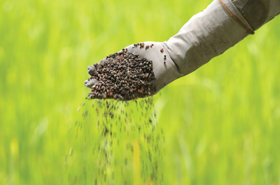Q. As a new gardener I was wondering why one must fertilize container plants frequently. If you buy good plants, have good soil and take care of them, why then is fertilizer necessary? In addition, why does 0-10-10 help plants bloom? Won’t they bloom on their own?
A. You’re probably correct about having to feed often but only if you’re talking about a few weeks or maybe a month for container plants and a bit longer for landscape trees and shrubs. Plants require nutrients to grow and thrive without them they will struggle and eventually die. One of the functions of roots is to absorb nutrients. The nutrients are then transported upward throughout the plant. Nutrient depreciation or loss in containers is rapid because every time you water, which is frequently, water carries them away as the container drains. It’s important to recognize that container plants have perfect drainage verses those planted in our clay or adobe soil that drains poorly. In addition, the roots are restricted to a pre-defined area, the pot size while those plants in the ground have plenty of room to expand beyond their canopy. Soil microorganisms are also present absorbing organic matter and converting them into nutrients. Overtime the volume of soil disappears and is replaced with roots. The three primary elements necessary for plant growth are Nitrogen (N), Phosphorus (P) and Potassium (K), also known as NPK. There are ten or more secondary elements like Boron, Iron, Sulfur, Copper, Magnesium and others needed in lesser amounts. Nitrogen is necessary for growth and lush green foliage. It leaches quickly from soils because it is mobile element so it needs to be replaced frequently. Phosphorus and Potassium are for fruit and flower production, aids in the general plant hardness, and remains longer in our soils. The nutrient/fertilizer analysis is on every bag of fertilizer and is expressed as a percentage. The first number is always Nitrogen (N), next is the Phosphorus (P) and finally Potassium (K). On the back of every fertilizer bag, you’ll find a detail listing of all the elements including the secondary ones. Some plants fail to bloom when they are growing too vigorously while others are not affected by the growth cycle. Light and temperature are two other strong influences in flowering. Low or no nitrogen type fertilizers like 0-10-10 help plants bloom and are applied during the winter months to Bearded Iris, Citrus and others. Gardeners will switch to 0-10-10 with Fuchsias, Tuberous Begonias and other flowering once the desired size has been reached to maximize color. Today, we’re spoiled as we have many different types of fertilizers choices, such as time release, organic, water-soluble and synthetic. They’re all good answers but which one is the best? The Nursery Professional at your favorite garden center is the resource for plant specific fertilizers and fertilizing for you and your yard.
Buzz Bertolero is Executive Vice President of Navlet’s Garden Centers and a California Certified Nursery Professional. His web address is www.dirtgardener.com and you can send questions by email at dirtgarden@aol.com or to 360 Civic Drive Ste. ‘D’, Pleasant Hill, Calif. 94523 and on Facebook at Facebook/.com/Buzz.Bertolero
Leave a Reply